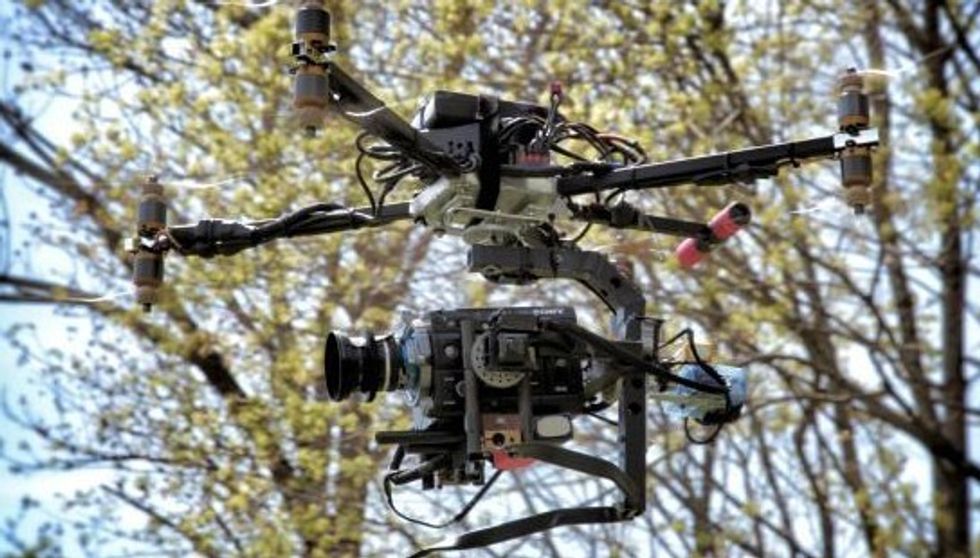FAA Has Decided to Allow 6 Studios to Use Drones. What Does This Mean for Indie Film?
The legality of how camera drones are used in film production in the US recently has been, at best, questionable.
Despite the bevy of tempting quadcopter/octocopter options that have become readily accessible in recent years, according to the Federal Aviation Administration you are technically not supposed to use Unmanned Aircraft Systems (UAS) for commercial film productions (with very few exceptions, such as the extreme wilderness in Alaska). Many productions have to opt to film in other countries due to the US regulations that prevent them from legally filming with the use of a UAS. That doesn't mean filmmakers don't still do it, effectively "stealing the shot." In fact, the FAA has even had to go so far as to release a "myth busting" sheet to curb misconceptions. Well, it should make drone enthusiasts rejoice, then, that the FAA is now beginning to allow certain studios exceptions to the FAA's rules concerning UASs, allowing them to operate without an FAA air-worthiness certificate (provided they can prove their productions are safe, don't fly at night, and are on a closed set). Check out this video from CBS for a recap:
From the press release from the FAA, here are the six companies:
The Motion Picture Association of America facilitated the exemption requests on behalf of these six members: Astraeus Aerial, Aerial MOB, LLC, HeliVideo Productions, LLC, Pictorvision Inc., RC Pro Productions Consulting, LLC, dba Vortex Aerial, and Snaproll Media, LLC. The FAA has asked for additional information from Flying-Cam, Inc., a seventh aerial video company that filed for exemptions with this group in June. The agency is working closely with the company to obtain the required information.
We've known since May that the regulations concerning UAVs/UAS's/drones would be under review soon. This clearly has big implications for the film production industry, and especially independent filmmaking in general. Aerial photography has seen a boom in recent years due to the increase in use of drones. Drones open up so many unique shots and options for creativity (even using the Oculus Rift for a true flying experience). They're priced in such a way that the barrier to entry is actually pretty low — a little over a grand for the DJI Phantom, for example, and you're in the aerial game. And if you're not producing commercially, you're in the clear as long as you're not operating over populated areas, or in areas denoted by this handy No Fly Zone map. (There does seem to be some grey area though concerning what makes a production "commercial" in the eyes of the FAA.)
One note on safety: some news outlets have suggested that a UAV could be "safer than using a helicopter" for the same kind of aerial shots. This strikes me as sort of nonsensical, and I have to disagree with it — yes, there will be different safety concerns, but not less. They sort of run with the suggestion that drones will be replacing "helicopter shots." But we all know that these affordable (and soon ubiquitous) drones will also be used in place of jib moves, dolly/steadicam moves, and certainly many combinations in between, not just bigger-budgeted aerial photography. I think safety will be a HUGE concern, and we will see more and more instances pop up like the situation in New York where a pedestrian almost was hit by one. I've even heard of crews hitting the control of a quadcopter and cutting themselves on the blades. (As Joe wisely noted in his title, these are not toys.) And drones being "safer" than a manned aircraft slowly maneuvering for shots doesn't ring true to me, either. I'm all for drones becoming mainstream, but "more accessible" does not mean "safer," and like with any technology, I think a big part of the drone discussion will revolve around safety in the future.
I think the big question here is will this easing up on the FAA's part usher in the new era of accepted, accessible, commercially viable UAS cinematography? They're certainly easing up in this move, and as Wired points out, there are several other companies outside of film production that want to use drones. It also doesn't hurt that the MPAA is putting its lobbying power behind it.
What do you think? Are we entering the new age of drone cinematography, or should we expect more roadblocks (especially given safety concerns)?















